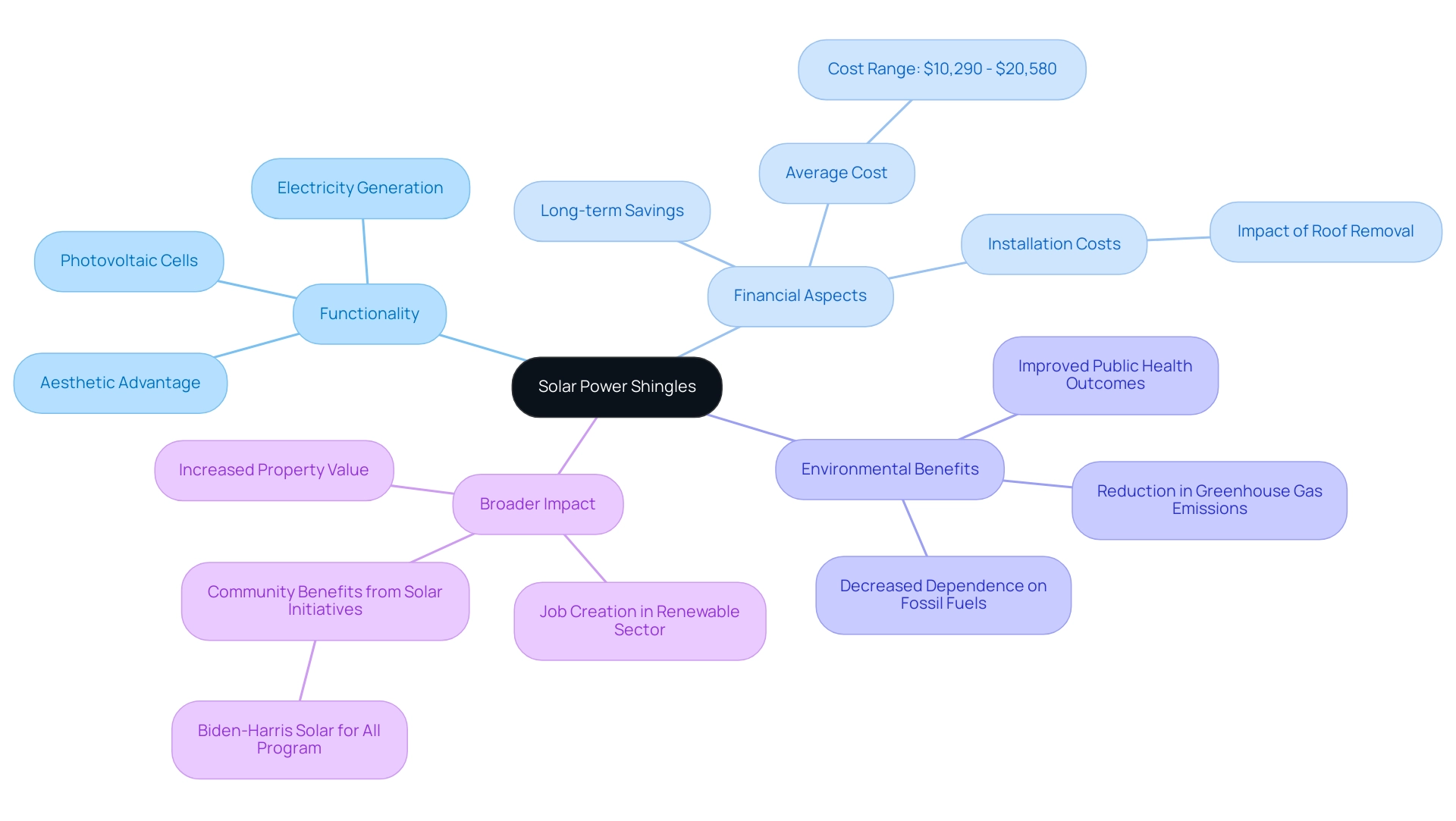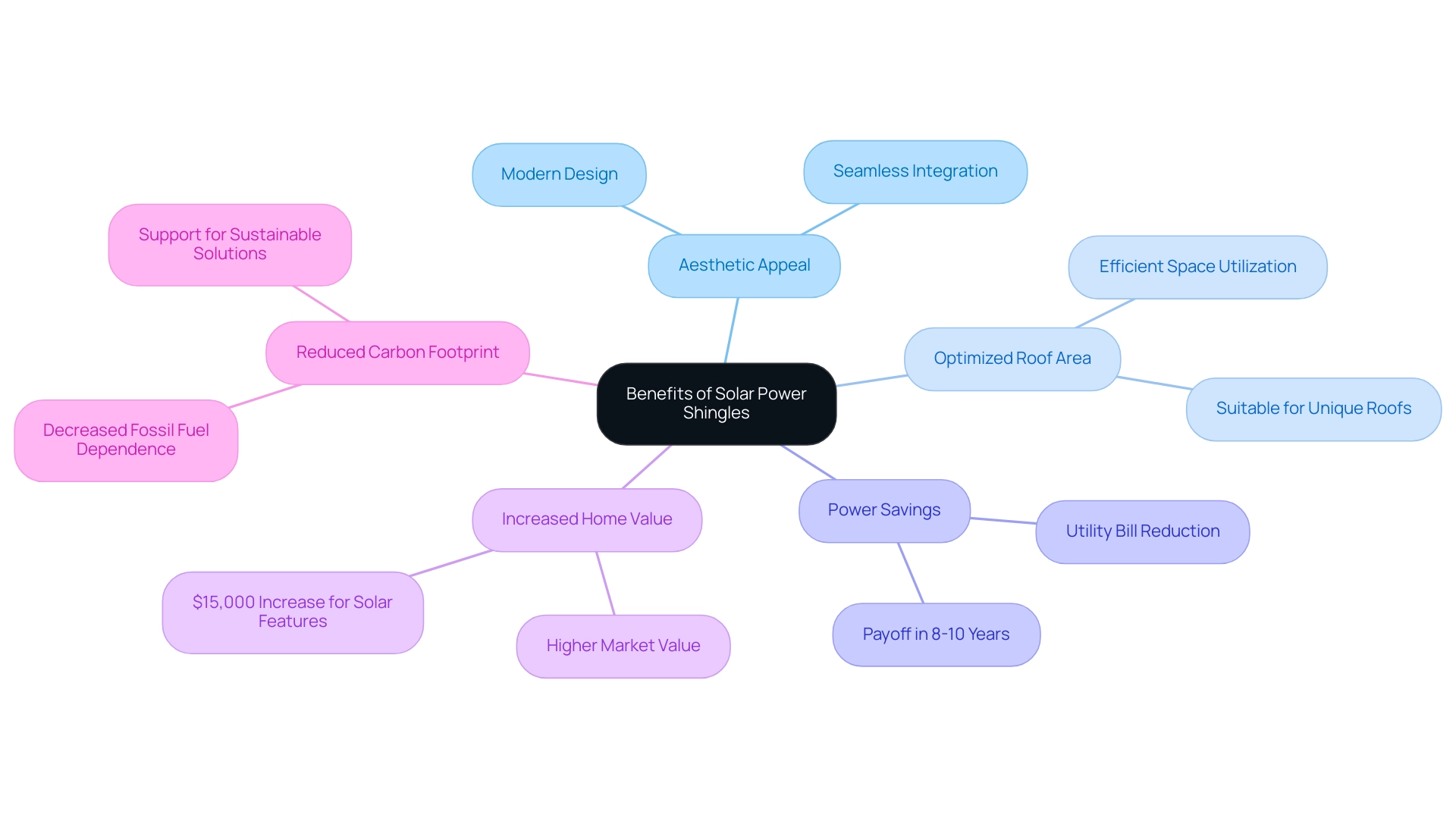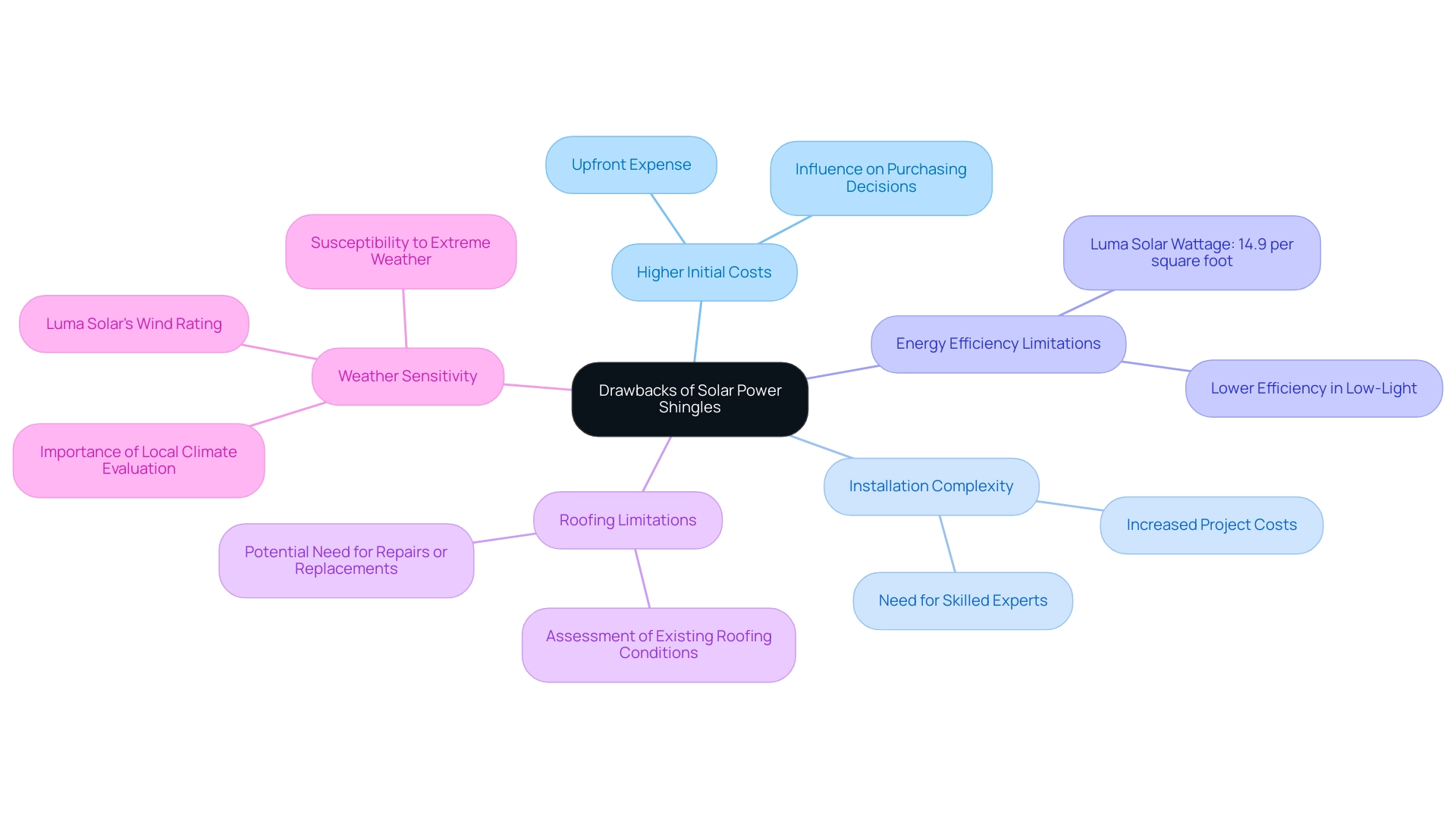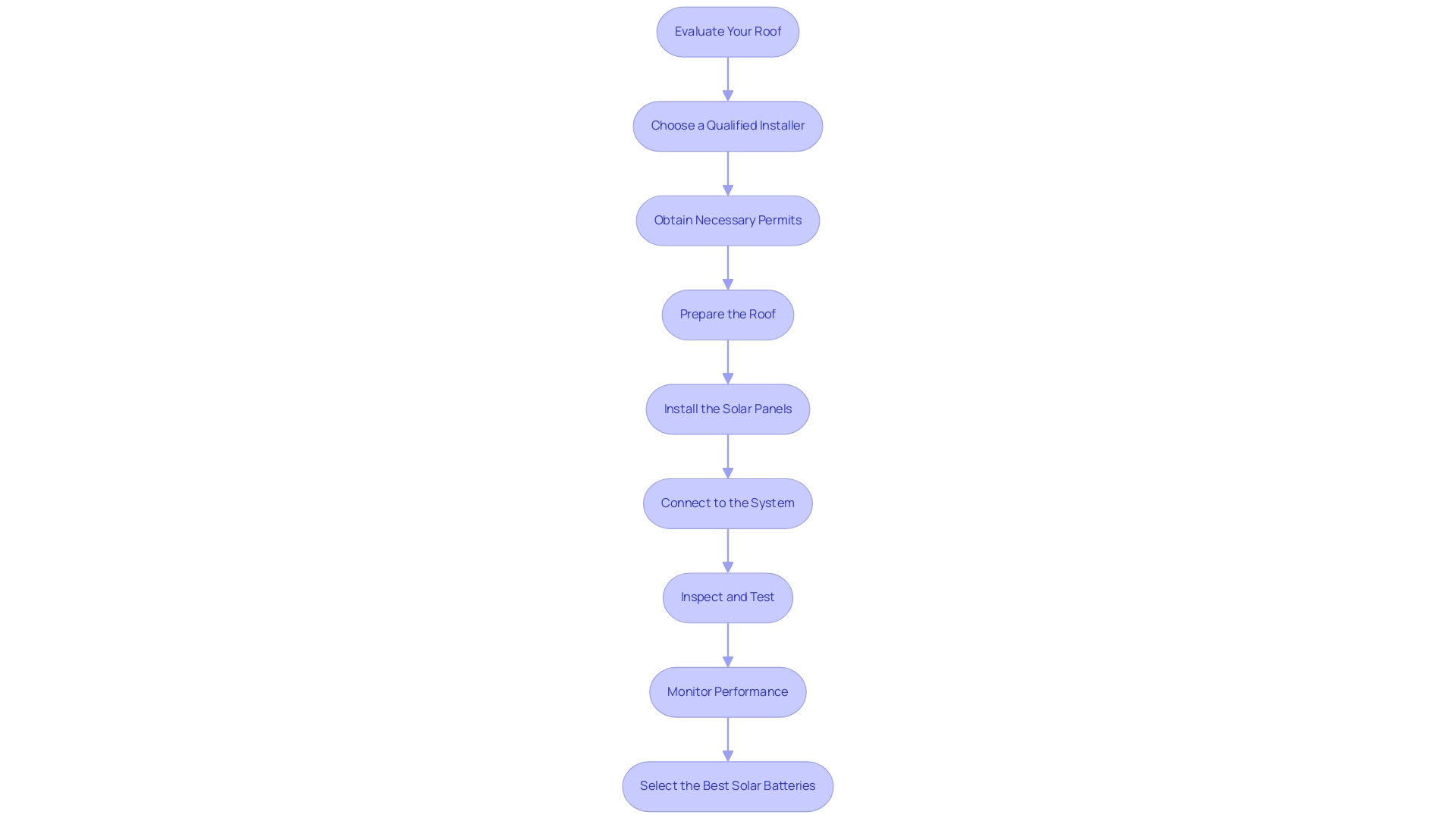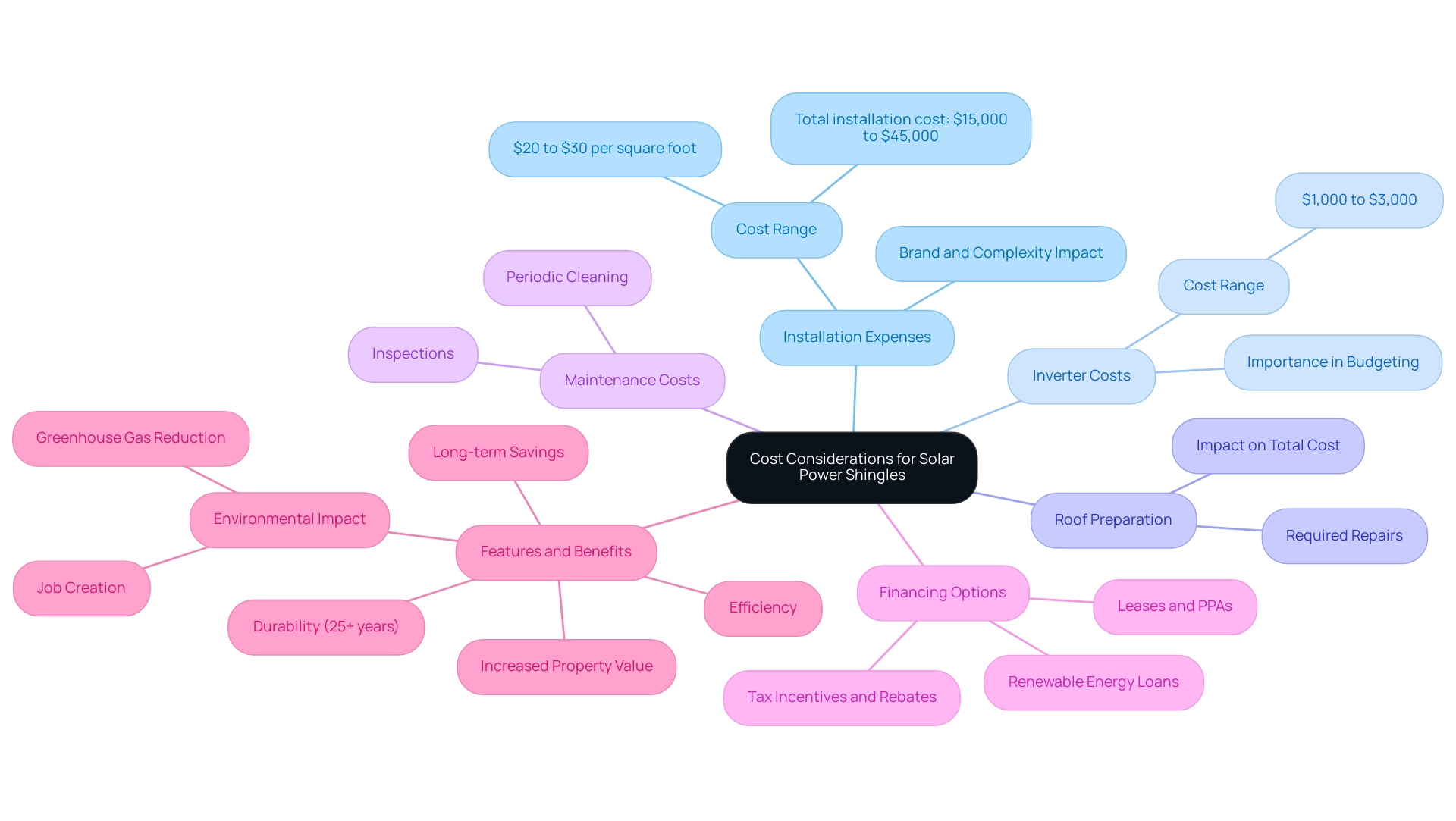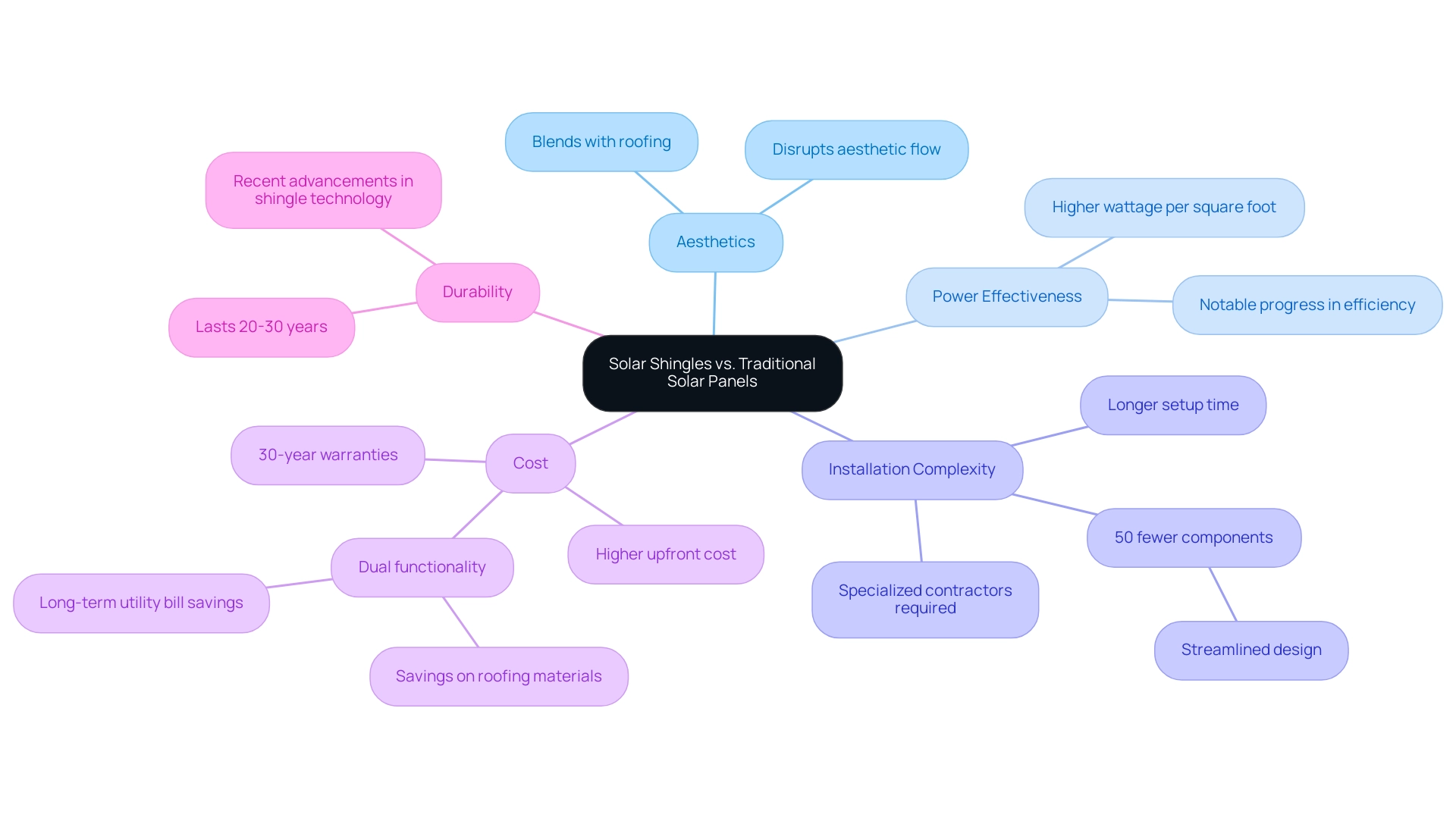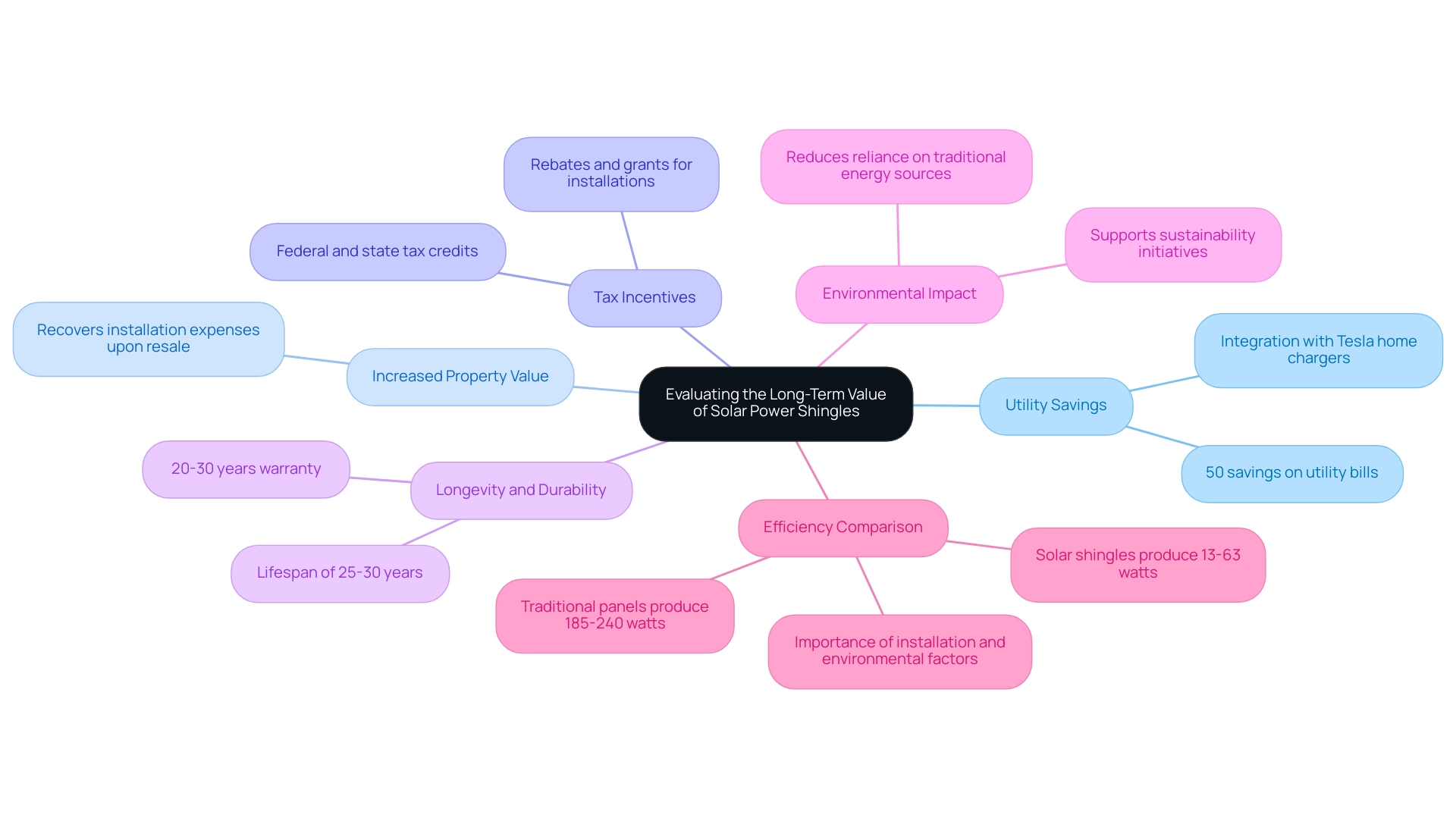Overview
Solar power shingles are innovative roofing materials that serve both as a protective layer for homes and as a means to generate electricity from sunlight through embedded photovoltaic cells. The article highlights their aesthetic appeal, potential for cost savings on utility bills, and environmental benefits, while also addressing challenges such as higher initial costs and installation complexity, thus providing a comprehensive understanding of their value in sustainable home improvement.
Introduction
As the demand for sustainable energy solutions continues to rise, homeowners are increasingly exploring innovative options that not only enhance their property but also contribute to a greener future. Among these options are solar power shingles, a cutting-edge roofing material that combines functionality with aesthetic appeal. These shingles serve a dual purpose: protecting homes while harnessing the power of the sun to generate electricity.
With advancements in photovoltaic technology, solar shingles offer an attractive alternative to traditional solar panels, allowing homeowners to seamlessly integrate renewable energy into their living spaces. However, as with any investment, it is essential to weigh the benefits against potential drawbacks, understand the installation process, and evaluate long-term value.
This article delves into the world of solar power shingles, exploring their advantages, challenges, and the financial considerations that come with making the switch to solar energy.
What Are Solar Power Shingles and How Do They Work?
Solar power shingles are innovative roofing materials designed to fulfill two essential roles: they protect your home and simultaneously generate electricity from sunlight. Each solar power shingle is embedded with advanced photovoltaic (PV) cells, similar to the technology utilized in conventional energy panels. When sunlight strikes these cells, they generate direct current (DC) electricity, which an inverter then converts into alternating current (AC) for household use.
This integrated system offers not only functionality but also an aesthetic advantage, allowing homeowners to maintain their property’s appearance while adopting solar power shingles as a renewable energy solution. The average cost of a residential energy system ranges from $10,290 to $20,580, providing a financial perspective for those considering this investment. Furthermore, it’s essential to mention that taking off an existing roof can increase the installation expense of shingles, with charges differing according to the roofing material and removal complexity.
As mentioned by Marty Ford, a Shingle Master and President of Bullet Proof Roof Systems, ‘I am very excited about the possibility of roofs that harness solar energy.’ Solar power shingles can assist in reducing your utility costs and even make your home self-sufficient. I believe this is a technology that has a lot of potential…
This reflects the growing excitement and promise of roofing technology, particularly with innovations like solar power shingles, marking a significant step forward in sustainable home improvements. Furthermore, solar heating systems not only improve power independence and significantly lower utility expenses but also aid in reducing greenhouse gas emissions and dependence on fossil fuels. The financial benefits encompass long-term savings on utility bills and the potential for job creation in the renewable sector, which can stimulate local economies.
Initiatives like the Biden-Harris administration’s $7 billion Solar for All program aim to ensure equitable access to these renewable solutions, thereby benefiting a broader range of communities. Moreover, photovoltaic facilities, which convert sunlight into electricity for residences and businesses, illustrate the wider influence of this technology on renewable resources, aiding in diminished dependence on fossil fuels. It is also important to recognize that residential net metered energy installations can lead to improved public health outcomes by reducing air pollution associated with fossil fuel energy sources.
The Benefits of Installing Solar Power Shingles
The installation of solar power shingles presents a variety of significant benefits for homeowners:
-
Aesthetic Appeal: One of the most compelling advantages of photovoltaic tiles is their ability to integrate seamlessly with your roof, enhancing the home’s overall design. They provide a modern appearance that attracts many property owners, making them a favored choice over conventional energy panels.
A case study titled ‘Top Benefits of Solar Power Shingles’ emphasizes that property owners favor solar power shingles for their visual benefits, as they integrate effortlessly into home designs. Bianca Howard, director of the Building Energy Research Lab at Columbia University, observes,
Because if you have a higher wattage per square foot, then that’s a better material in terms of power output,
emphasizing that aesthetic and functionality can go hand in hand.
-
Solar power shingles optimize roof area, allowing property owners to capture sunlight without the necessity for large panels. This efficiency is particularly valuable for homes with limited roof area or unique architectural features.
-
Power Savings: By producing their own electricity, homeowners can significantly reduce their utility bills. Many find that the savings on utility costs contribute to a favorable return on investment over time. In fact, investing in solar power shingles can yield a payoff within 8 to 10 years, making it a financially sound decision.
-
Increased Home Value: Homes equipped with energy systems are often valued higher in the real estate market. Buyers are willing to pay up to $15,000 more for properties equipped with roofing features that utilize renewable energy, highlighting the financial benefits of installation.
This statistic highlights the value enhancement that solar power shingles can provide to homeowners.
-
The use of solar power shingles to harness sunlight significantly decreases dependence on fossil fuels, consequently minimizing your carbon footprint.
This shift not only contributes to a more sustainable future but also aligns with the growing consumer preference for eco-friendly home solutions. Additionally, solar power shingles aid in power autonomy by enabling residences to produce their own electricity. Alongside these benefits, property owners can also utilize government initiatives designed to encourage the adoption of renewable solutions, access to premier panel cleaning services, and various battery choices that improve efficiency.
Furthermore, combining photovoltaic roof tiles with Tesla home chargers can enhance power management at home, demonstrating the synergy between various renewable power solutions. Overall, the advantages of installing solar power shingles go beyond simple aesthetics, positively affecting energy savings, property value, and the environment while placing residents at the forefront of the renewable energy movement.
Understanding the Drawbacks of Solar Power Shingles
While photovoltaic tiles provide various advantages, it is essential to acknowledge their disadvantages:
- Higher Initial Costs: One of the main obstacles for homeowners is the upfront expense of photovoltaic tiles, which often surpasses that of conventional energy panels. This financial consideration can significantly influence purchasing decisions.
- Installation Complexity: The setup of photovoltaic tiles requires specialized knowledge, making it crucial to hire skilled experts. This requirement can elevate overall project costs, creating an additional barrier for potential buyers.
- Energy Efficiency Limitations: In terms of performance, photovoltaic tiles generally exhibit lower energy efficiency compared to conventional panels, particularly in low-light conditions, which can affect overall energy generation. For example, Luma Solar’s tiles have a wattage of 14.9 per square foot, indicating a performance metric that may not meet the expectations of all homeowners.
- Roofing Limitations: The necessity for roof repairs or replacements can complicate the feasibility of installing photovoltaic tiles, as existing roofing conditions must be assessed before proceeding with installation.
- Weather Sensitivity: Compared to traditional panels, shingles may be more susceptible to extreme weather conditions, necessitating a comprehensive evaluation of local climate factors before installation. As pointed out by Luma Solar, although their products rated lower than leading rivals, their exceptional wind rating is a crucial factor for residents in regions susceptible to extreme weather.
Furthermore, homeowners should contemplate the possible benefits of renewable power solutions, such as the supportive government programs available for installations, the efficiency of battery options for storage, and the convenience of integrated systems like Tesla home chargers. Moreover, the upkeep aspect is vital; employing premium panel cleaning services can improve the durability and effectiveness of both energy panels and roofing materials. Given these challenges, along with insights from case studies indicating a promising future for the photovoltaic roofing market driven by increasing clean energy demand, the choice to install photovoltaic materials should be made with careful consideration of both the short-term and long-term implications.
Step-by-Step Guide to Installing Solar Power Shingles
To successfully install power tiles, carefully follow these steps:
- Evaluate Your Roof: Perform a comprehensive examination to assess the roof’s state and its appropriateness for photovoltaic tiles, taking into account elements such as age and structural soundness.
- Choose a Qualified Installer: Selecting a certified installation company experienced in photovoltaic roofing is crucial, as this ensures quality workmanship and adherence to industry standards.
- Obtain Necessary Permits: Research local building codes and regulations, and secure any required permits before commencing installation to avoid delays.
- Prepare the Roof: Address any necessary repairs or replacements of roofing materials to create a solid foundation for the roofing tiles.
- Install the Solar Panels: The installer will place the solar panels in overlapping rows, ensuring they are properly sealed and that all electrical connections are secure.
- Connect to the System: Once installed, the shingles will be connected to an inverter, which converts the generated electricity into usable power for your home.
- Inspect and Test: Following installation, a comprehensive inspection and testing of the system will confirm that everything is functioning optimally.
- Monitor Performance: Employ monitoring tools to keep track of power production and efficiency over time, which is vital for ensuring your system operates at its best.
- Select the Best Solar Batteries: Consider options like lithium-ion or lead-acid batteries, focusing on capacity, efficiency, and warranty to ensure effective energy storage.
Comprehending how photovoltaic panels function—transforming sunlight into electricity via photovoltaic cells—is crucial for optimizing the advantages of your shingles. As mentioned by Marty Ford, a Shingle Master and President of Bullet Proof Roof Systems, “I am very excited about the possibility of solar power shingles.”
[Solar roofs] can assist in reducing your utility costs and even make your home self-sufficient.“I think this is a technology that has a lot of potential, and I anticipate entering the field in the near future.” This quote emphasizes the substantial advantages of solar power shingles, resonating with the environmentally aware attitude of property owners. Additionally, any design changes impacting energy production by 2.5% or more will necessitate a change order and require homeowner approval, ensuring that your installation aligns with your energy goals.
Most photovoltaic roofing options are protected by a 25-year warranty, providing peace of mind regarding your investment. The entire process, from assessment to final inspection, can take anywhere from two to nine months, depending on various factors, so planning ahead is essential. Regular upkeep is essential; although cleaning expenses for photovoltaic tiles are not extensively recorded, typical cleaning for these panels varies between $300 and $600 each year, with rain and snow offering natural cleaning advantages, thereby ensuring efficiency and durability.
Cost Considerations for Solar Power Shingles
When considering the installation of photovoltaic roof tiles, property owners must assess several key cost factors:
- Installation Expenses: The cost for photovoltaic tiles typically ranges from $20 to $30 per square foot, affected by the brand and intricacy of the setup. This range reflects the product’s quality and the intricacies involved in the installation process. Overall, you can expect to spend anywhere from $15,000 to $45,000 for a roof panel installation or replacement, which provides a broader financial context for homeowners considering renewable roofing.
- Inverter Costs: Essential for converting direct current (DC) into alternating current (AC) electricity, inverters can add between $1,000 and $3,000 to the overall expenses. This is a crucial component that should not be overlooked in the budgeting phase.
- Roof Preparation: Any required repairs or reinforcements to the existing roof structure can significantly impact the total installation cost. Establishing a strong base is essential for the durability and effectiveness of the energy panels.
- Maintenance Costs: While photovoltaic shingles are designed for durability and require minimal upkeep, periodic cleaning and inspections may lead to additional costs over time. Homeowners should plan for the occasional expenses as part of their overall investment.
- Financing Options: To reduce the strain of initial expenses, many property owners investigate financing alternatives like renewable energy loans, leases, or power purchase agreements (PPAs). These options enable the allocation of costs over time, making renewable power more accessible and manageable. Additionally, homeowners can take advantage of tax incentives and rebates that can significantly reduce the overall cost of installation, enhancing the financial appeal of solar roofing.
- Features and Benefits: Solar power shingles not only offer efficiency by converting sunlight into electricity but are also built for durability, often lasting 25 years or more. This longevity contributes to long-term savings on utility bills and increases property value. By understanding these aspects, property owners can make informed choices that align with their financial circumstances. Moreover, adopting renewable energy contributes to job creation and greenhouse gas reduction, aligning homeowners with equitable access initiatives and a more sustainable future.
Solar Shingles vs. Traditional Solar Panels: A Comparative Analysis
When assessing rooftop tiles compared to conventional photovoltaic panels, several key factors warrant consideration:
- Aesthetics: One of the main benefits of photovoltaic tiles is their design, which enables them to blend effortlessly with current roofing materials, resulting in an attractive solution that improves the home’s overall appearance. In contrast, traditional panels are installed on top of the roof, often disrupting the aesthetic flow.
- Power Effectiveness: Although conventional photovoltaic panels typically demonstrate greater power conversion rates, roof tiles have achieved notable progress in efficiency. Homeowners should be aware that the wattage rating of photovoltaic shingles—measured in watts per square foot—plays a crucial role in determining power output. As indicated in case studies, higher wattage per square foot means fewer roofing materials are needed to meet energy demands, potentially lowering overall installation costs and improving energy efficiency.
- Installation Complexity: The setup procedure for photovoltaic tiles is usually more complicated and takes longer than that for conventional panels. Specialized contractors may be required to ensure proper integration with the roofing system, which can lead to longer lead times and increased labor costs. Significantly, photovoltaic tiles have 50% fewer components than traditional rack-mounted systems, as emphasized by SunTegra, streamlining design and possibly improving reliability.
- Cost: Although solar power shingles frequently have a higher upfront cost, they serve a dual purpose by acting as both roofing and power generation systems. This dual functionality can offer long-term savings on roofing materials and utility bills. Moreover, the 30-year warranties from Forward Labs and Tesla for both power production and weatherization underscore the long-term value and durability of these products.
- Durability: Both photovoltaic tiles and conventional panels are designed to withstand severe weather conditions. However, traditional panels have a well-established track record for longevity, often lasting between 20 to 30 years. Recent advancements in shingle technology have also led to improved durability, making them a competitive option in terms of lifespan.
In addition to this comparative analysis, property owners should also explore the benefits of EV charging stations, like the Tesla home charger, which aligns well with the installation of renewable power systems. A step-by-step guide for installing an EV charging station can offer practical insights for individuals looking to enhance their energy solutions. Government initiatives promoting photovoltaic adoption and the availability of cleaning services for optimal performance further underscore the practical benefits of investing in this technology.
This analysis not only underscores the benefits of each option but also helps homeowners make informed decisions based on aesthetics, efficiency, and practicality.
Evaluating the Long-Term Value of Solar Power Shingles
Evaluating the long-term value of solar power shingles requires a thorough examination of several key factors:
- Utility Savings: Homeowners can expect significant reductions on their bills, with many reporting decreases of 50% or more over time. This significant decrease is particularly beneficial as the cost of conventional power sources continues to rise, further amplified by the potential integration with Tesla home chargers, which optimize resource use.
- Increased Property Value: Residences fitted with energy systems, including photovoltaic tiles, often see a significant rise in property value. Research suggests that these assets can recover their installation expenses upon resale, making photovoltaic tiles not only an energy-efficient option but also a financially wise investment.
- Tax Incentives: Homeowners can take advantage of various federal and state tax credits designed to encourage renewable energy installations and energy-efficient upgrades. These incentives can significantly enhance the financial advantages of choosing solar panels, making them a more appealing option alongside government programs aimed at promoting sustainable energy solutions, such as rebates and grants for solar energy installations.
- Longevity and Durability: Solar tiles are engineered for durability, typically featuring warranties that span from 20 to 30 years. In fact, they have a lifespan of 25 to 30 years, offering individuals peace of mind, knowing their investment is safeguarded for decades.
- Environmental Impact: Investing in renewable roof tiles not only supports individual financial objectives but also contributes to wider sustainability initiatives. By reducing reliance on traditional energy sources and integrating battery options for efficient energy storage, homeowners align their values with eco-friendly practices, promoting a cleaner and more sustainable future.
Alongside these aspects, it’s crucial to evaluate the effectiveness of roof tiles in comparison to conventional photovoltaic panels. While photovoltaic tiles generate between 13 and 63 watts each, as reported by the U.S. Department of Labor Statistics, traditional panels produce significantly more, between 185 and 240 watts. This difference highlights the importance of proper installation and environmental considerations to maximize efficiency.
A case study titled “Solar Shingles vs. ‘Panels: Efficiency and Power Generation'” emphasizes that the angle of the roof and environmental factors significantly affect the performance of energy systems. Ultimately, the long-term value of solar power shingles includes not only financial savings but also a commitment to sustainable living, which is enhanced by the integration of solar cleaning services that help maintain efficiency and advanced energy solutions.
Conclusion
The exploration of solar power shingles reveals a promising avenue for homeowners seeking sustainable energy solutions that marry functionality with aesthetic appeal. By understanding their dual role as both roofing material and energy generators, homeowners can appreciate how solar shingles not only protect their property but also contribute to significant energy savings and environmental benefits. The integration of advanced photovoltaic technology allows these shingles to blend seamlessly with existing architecture while providing a viable alternative to traditional solar panels.
However, it is essential to weigh the initial investment against the long-term value. Although the upfront costs may be higher, the potential for increased property value, substantial energy savings, and access to government incentives can enhance the overall financial appeal. Moreover, the longevity of solar shingles, supported by warranties of up to 30 years, underscores their durability as a sound investment.
Ultimately, the decision to install solar power shingles should be informed by a thorough understanding of both their advantages and limitations. Homeowners should consider their unique circumstances, including roof conditions and local climate factors, to make an informed choice. Embracing solar technology not only fosters energy independence but also aligns with the broader movement towards a more sustainable future, making solar shingles a compelling option for those looking to contribute positively to the environment while enhancing their home.



